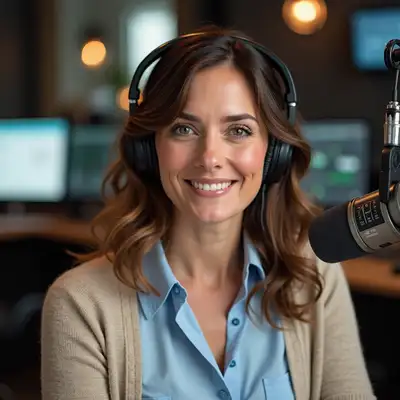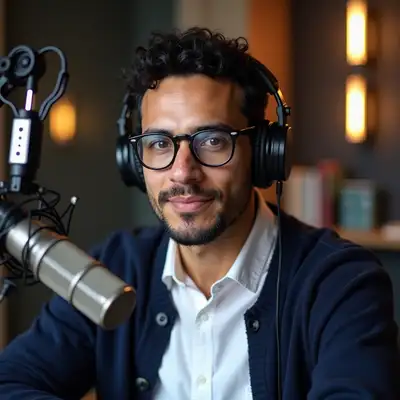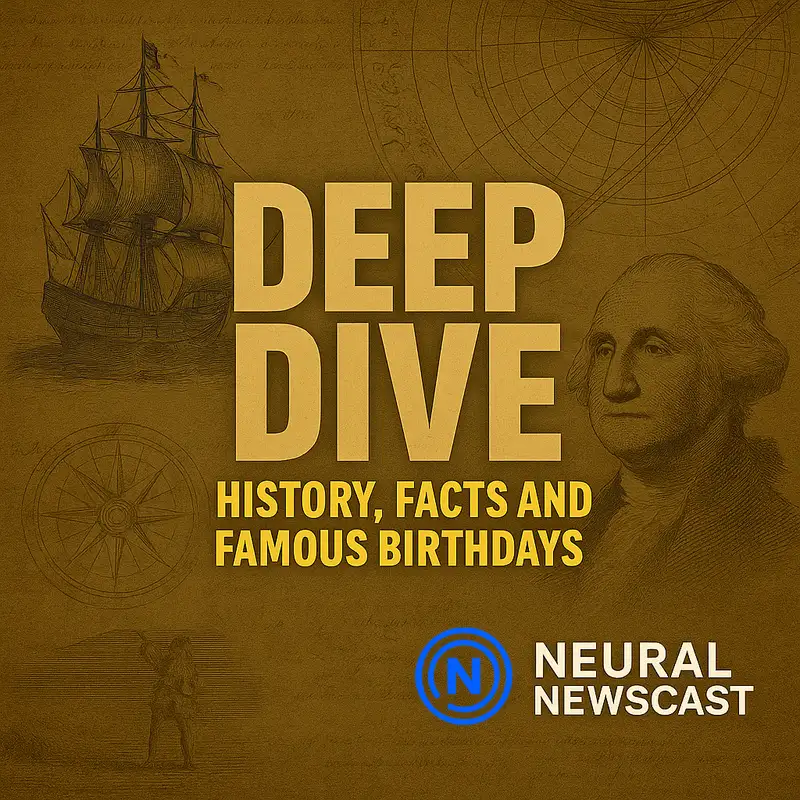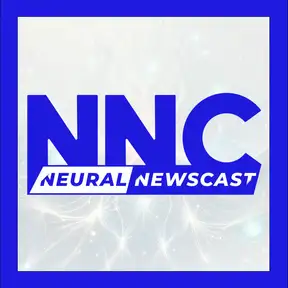Deep Dive: From Radio Waves to Cosmic Wonders: Soccer, Sagan, and Science Mysteries - May 27, 2025
You're listening to Neural Newscast, exploring the stories, history, and ideas that shape our world.
This is NNC.
Thanks for joining us for this Neural Newscast Deep Dive.
I'm Nathaniel, and alongside Laura, we're about to uncover some intriguing stories.
On this day, back in 1930, something pretty remarkable happened in the UK.
You know, the first ever radio broadcast of a soccer match took place.
Yes.
It was a game changer, literally and figuratively, for how people consumed sports back then.
Oh, right.
I can imagine the thrill for the fans, hearing live commentary while sitting in their living rooms.
For many, it must have felt like being at the stadium.
Did they broadcast the whole game, Nathaniel?
They did. It was from Highbury, where Arsenal played.
Before this, fans relied on printed reports or maybe a quick update over the phone,
but suddenly they could experience the play-by-play action as it happened.
It was revolutionary.
And not just for the game itself.
Think of the connection it forced creating a shared experience across Miles.
People who couldn't travel or afford a ticket were suddenly part of a larger community.
Exactly.
And, you know, the commentators back then had to paint vivid pictures with their words.
It was an art form, making listeners feel the tension and excitement of the match.
Do you remember that aspect of storytelling?
Absolutely, Nathaniel.
It's fascinating how they had to be so descriptive.
It requires a certain skill to make people visualize a player sprint or the crowds roar through
just words.
In a way, they were the pioneers of the immersive sports commentary we have now.
That's so true.
And this first broadcast led to a new era where fans became more invested in their teams.
You couldn't just read about a team and feel the highs and lows in the same way, right?
Definitely.
Listening live, you get the adrenaline and emotion.
It's a shared pulse that brings people together.
I bet it even influenced how people interacted socially, gathering around the radio with family
and friends.
Yes, it made sports a communal event.
Plus, it laid the groundwork for modern sports media.
Today, live sports broadcasting is a massive industry.
Yet, it all started with that leap from print to radio.
And think about the health implications, too.
Social connections play a crucial role in mental health, and shared experiences like this
were early examples of media's power to foster community and reduce isolation.
Such a good point, Laura.
It's fascinating to see how a simple soccer match broadcast had ripple effects beyond just sports.
It reshaped media, social interaction, and even had health benefits.
Quite the legacy for a single event.
It really is.
And it's a reminder of how technology can transform lives in unexpected ways.
Who would have thought that one broadcast could pave the way to the media landscape we know today?
Music
Today we celebrate the birthdays of Alfred Nobel, 1833, Marie Curie, 1867, and Carl Sagan, 1934.
Oh, Carl Sagan, now there's a name that really stands out.
His work has inspired so many people to look up at the stars with wonder.
Absolutely. Carl Sagan's influence on bringing the cosmos to the masses can't be overstated.
A series, Cosmos, a personal voyage, really opened up a whole new universe for the average
viewer, wouldn't you say?
Definitely.
And beyond just his broadcasting, his work in planetary science and his involvement with
NASA on projects like the Voyager missions left a huge mark.
Exactly.
Sagan was instrumental in the golden record that's out there traveling through space.
Isn't it fascinating to think about how he curated these greetings and sounds to potentially
introduce humanity to extraterrestrial life?
It's mind-blowing, really.
He had such a knack for blending science with a kind of poetic curiosity.
One thing that always strikes me is how he emphasized our shared connection across the planet,
famously calling Earth a pale blue dot.
Right.
The pale blue dot perspective is so humbling.
It encourages us to see ourselves as one species sharing a fragile environment.
Sagan was so ahead of his time in understanding the importance of global cooperation and sustainability.
He really was.
He had this profound ability to connect the cosmic to the personal,
which is something we often try to do in health reporting to, linking complex science to individual lives.
Well said, and while his contributions to science communication were immense, he was also
quite active in advocating for this scientific method and rational thinking and policymaking.
His insights remain relevant in today's discussions on science and society.
Exactly.
His legacy continues through those inspired to pursue careers in science, seeking to unravel
the mysteries he's so beautifully introduced to us.
It's a lasting testament to how one person's passion and clarity can light up the world for so many.
We'll be right back after this short break.
You're listening to Neural Newscast.
Fresh Insights Every Day.
Catch up on past episodes anytime at NNewscast.com.
Welcome back to Neural Newscast Deep Dive.
Let's continue our exploration.
Have you come across this intriguing case known as the girl with twin fathers, Laura?
It's a captivating blend of genetics and biology.
I have Nathaniel.
It's like something out of science mystery novel, isn't it?
The idea that a child could have two genetic fathers is fascinating, almost like rewriting
the genetic rulebook as we know it.
Exactly.
The explanation lies in a rare genetic anomaly called chimerism.
It's where an individual has two sets of DNA, essentially combining cells from more than
one fertilized egg.
Right, and in this particular case, the mother had fraternal twins, but their genetic material somehow merged during early development, resulting in one child with DNA from both embryos.
It's like having a living mosaic of genetic materials.
What's especially remarkable is how this phenomenon challenges our understanding of parentage and reproduction.
It brings up questions about identity, inheritance, and even the boundaries of human biology.
And it makes us reconsider the complexities of genetics in everyday life.
Imagine growing up and discovering you technically have genetic material from two fathers.
For the family involved, it's a revelation that must have been both astonishing and, perhaps, a bit disorienting.
Indeed. From a scientific perspective, it opens up discussions about the nature of individuality and genetic identity.
But beyond science, there's a deeply human element to this story, how families understand and adapt to these revelations.
And think about the implications in medicine as well.
Genetic testing, organ matching, and even personalized treatments could become more nuanced with
tastes like this considered.
It adds layers to the idea of genetic compatibility.
True.
And it prompts scientists to look closer at the hidden complexities within our DNA.
It's less about rewriting the rulebook and more about recognizing that the rulebook is far more
intricate than we once thought.
Absolutely, Nathaniel.
This little girl is a reminder of the wondrous variability inherent in nature and how,
as science advances, we're continually uncovering these hidden narratives within our genetic
code.
And that's precisely what makes this case so enthralling.
It's not just a scientific anomaly, it's a story of human diversity at its most fundamental level.
The more we learn, the more we appreciate the complexity of life's tapestry.
It certainly keeps our work exciting, doesn't it?
Constantly learning and sharing stories like this one, which challenge what we think we know.
It's a reminder that science is always full of surprises.
That's all for this Neural Newscast Deep Dive.
On behalf of Nathaniel and myself, Laura, thanks for listening.
From daily summaries to deep storytelling, Neural Newscast keeps you informed.
Visit NeuralNewscast.com. For more ways to listen and explore,
Neural Newscast merges real and AI-generated voices to ensure rapid, high-quality news production.
Our content is created using advanced AI models and rigorously reviewed by humans for accuracy and fairness.
Despite efforts to prevent AI errors, occasional inaccuracies may occur.
We encourage listeners to cross-check critical details with trusted sources.
Read about our AI transparency at NNewscast.com.
Creators and Guests




